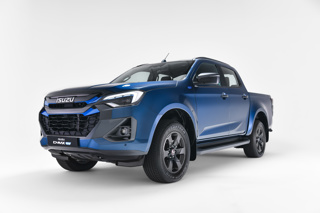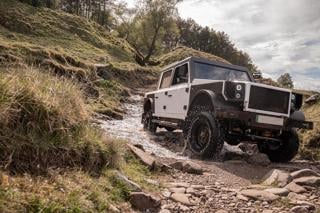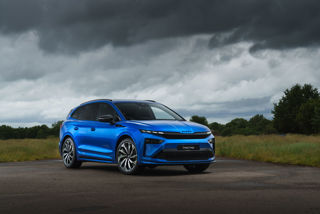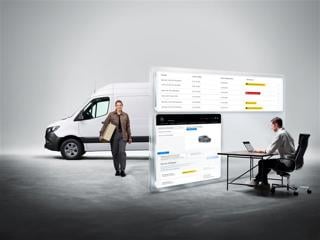With fleets looking to decarbonise all areas of their operations, a UK manufacturer of vehicle-mounted access platforms has developed a self-charging hybrid electric system, which can cut emissions and costs.
Unlike traditional power take-off (PTO) systems, which enable power to be transferred from an idling engine to a platform’s hydraulic system, Aldercote’s E-Drive system only pumps the oil that it needs.
Aldercote technical director, Marc Paish, told Fleet News that, compared to a PTO system, it is “superior” in every way. “It’s more reliable, smoother, faster, quieter, cleaner. It isn’t even any heavier,” he said.
An idling van burns a litre of diesel per hour. Based on the conservative use of a platform for three hours per day, 200 days per year, Paish suggests a saving of 600 litres of fuel per year – the equivalent of £900 in diesel – and an annual saving of 1.5 tonnes of CO2.
An engine will use about 10 kilowatts of power on when ticking over, which Paish says is far more than is needed. In fact, between 90-98% of fuel is wasted with diesel engines when operating an access platform.
He explained: “Most of that 10kW is just dissipated as heat... 3% efficiency is just an insult to any engineer. Using the engine is just a bad solution.”
Paish says that previous electric-powered access platforms used hydraulic systems that were designed to be coupled to an engine without considering how they should be adapted for an electric motor.
Working during lockdown, he said: “We started from a blank sheet of paper and reconfigured our hydraulic system to be so that it would be as efficient as possible when driven by electric motor.”
The average over the cycle is only 800 Watts. If the time spent at full reach is three minutes, the average requirement falls to 250W.
The solution therefore only requires two conventional lead acid batteries, which are recharged during transit, meaning there is no need to plug in.
They can power around 20 lifts on one charge before the engine needs to be switched on to recharge.
Aldercote’s head of sales and marketing, Steve Beedle, explains that the E-Drive system understands the hydraulic pressure, volume of fluid moved and the speed the drive motor is turning, which reduces the number of “complicated and exposed” sensors and allows the boom to move at maximum speed through its raise, lower and rotate function.
He added: “Our system only pressurises what’s required for a specific movement, rather than a constant pressure drive, thus reducing the heat in the system without the need for oil and filter replacements and, because we reduce the stress on both the host vehicle and the platform, wear and tear issues are reduced.”
Aldercote is also trialling lithium-ion batteries which are 10kg lighter and can offer up to 50 lifts.
“That’s an option for some customers,” said Paish. “But most customers don’t need to worry about doing more than 20 cycles without going anywhere in between. A couple of cheap car batteries is more than adequate for most people.”
The system can also work with fully electric vans. “The vehicle manufacturers differ slightly in how they’re providing power for ancillary equipment,” Paish explained. “But most of them are providing some form of 12-volt or 24-volt power.
“If it’s 24-volt we don’t need to charge; if it’s 12-volt, then we just use our existing system.”
‘Faster and quieter’
With the E-Drive system not having to rely on engine turnover, it provides full-control over the energy flow allowing for the access platform also to be operated at a faster rate.
Beedle explains that in a comparison test removing Christmas lights from trees, a council found that the electric-powered platform was able to do six more trees than an old PTO system in the same amount of time.
Tests suggest that the system is also relatively quiet, with peak noise no higher than 55 decibels, which is similar to an office conversation and a lot less than the 65db reported from a Vauxhall Movan ticking over.
Beedle said: “Although the Aldercote platform looks very similar to the competition, our technology and innovation demonstrate clear advantages to the operator in the basket, the business operating the platform and the communities where the E-Drive delivers quiet, pollution-free operation.”
A number of fleets have already replaced PTO systems with Aldercote’s electric access platforms. Paish said: “All we hear from our operators is that they're better to use and reliable.”
Openreach has deployed the electric access platforms on a number of its vans. Ian Belton, an engineer at Openreach, likened the system to a “breath of fresh air”.
“It’s like going from a Model T Ford to a Rolls Royce,” he said.
Fleets can choose from the company’s van-mounted platform, the VZ range, or its recently launched pick-up-mounted access platform, the CZ range.
The VZ range, which includes the base vehicle is priced from £62,800 depending on specification, numbers ordered ansd vehicle required offers heights from 13.7 metres to 18.3m and an outreach of up to 11m on vehicles from 3.5 tonnes to 7.2t.
Meanwhile, the CZ range for pick-ups, which is priced from £59,800 depending on specification, numbers ordered and vehicle required, offers heights from 14.1m to 16,2m, and an outreach from 6.9m to 8.1m.
For E-Drive mounts only, prices start at £33,500 again depending on specification, numbers ordered.























Login to comment
Comments
No comments have been made yet.